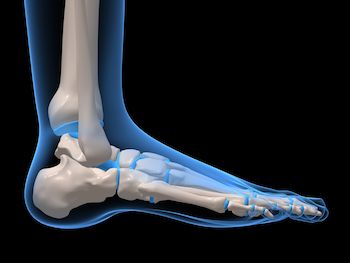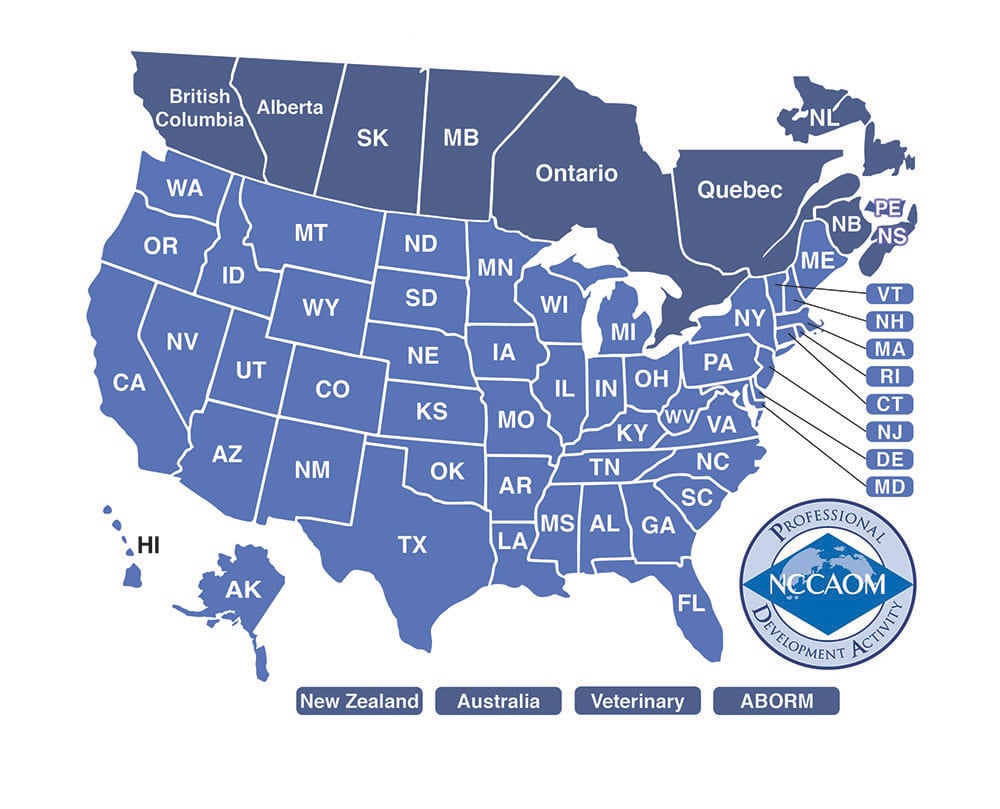Plantar Fasciitis Course Sample
Acupuncture CEUs & PDAs Online Example

Biomedicine Section Example
Anatomy and Physiology
Plantar fasciitis is a condition commonly encountered in the clinical setting. Every year, approximately two million people in the US seek treatment for this painful condition. The pain can be so intense that it interferes with work and daily activities. As the name implies, plantar fasciitis is an inflammatory condition affecting the plantar fascia. The condition is also referred to as inferior heel pain or sub-calcaneal pain.
The plantar fascia is a sheath or band of tissue that extends through the medial longitudinal arch. The plantar fascia almost entirely covers the plantar surface of the feet, and it has three portions (or bands):
- Medial
- Lateral
- Central
This important structure provides static support for the longitudinal arch of the foot. It also acts as a shock absorber through its limited ability to elongate.
The central portion of the plantar fascia originates from the medial process of the calcaneal tuberosity and extends to insert into each proximal phalanx (base of the metatarsophalangeal joints). Passive extension of the metatarsophalangeal joints tend to pull the plantar fascia distally (away from the body), which also increases the height of the foot arch.
One study in the Journal of Athletic Training describes a windlass mechanism in which the calcaneus, midtarsal joint, and metatarsals (medial longitudinal arch) create a triangle with the plantar fascia serving as the hypotenuse of the triangle. This mechanism explains how the vertical forces from the body tend to flatten the medial longitudinal arch. It also explains how the plantar fascia prevents the foot from collapsing due to the fascia’s anatomical position and tensile strength.
Causes of Plantar Fasciitis
Some patients who have plantar fasciitis may also have heel spurs, which are bony deposits. Although the two conditions often exist concomitantly, pain from plantar fasciitis should not be confused with pain due to heel spurs. Additionally, heel spurs do not cause plantar fasciitis. The idea that plantar fasciitis is due to heel spurs is in fact a common myth. Heel spurs occur in about 1 out of the 10 people, but only about 20% of those individuals will actually experience pain. So, when a patient complains of heel pain, plantar fasciitis should be considered as a primary cause.
Repetitive use, standing for long periods on hard surfaces, and injury from running and sports are some of the most common causes of plantar fasciitis. In fact, about 10% of athletic adults experience this condition. The repetitive nature of such activities strains the ligamentous structures and traumatizes the related nerves. Further, direct impact with heel strike causes microtears, which eventually results in pain and inflammation.
Plantar fasciitis also occurs frequently in women, particularly women ages 20 – 40 years, and middle, aged overweight individuals who are physically inactive. In the case of the women, high heels shoes appear to be the culprit.
Historically, researchers attribute plantar fasciitis to biomechanical problems or anatomic abnormalities.
These biomechanical factors include:
- Pes planus (flatfoot)
- Heel pronation
- Tight gastrocnemius muscles
- Cavus feet (high arch)
- Leg length discrepancies
Excessive pronation was once believed to be a significant biomechanical factor causing plantar fasciitis. Recently, however, research now indicates that overpronation does not always lead to lower extremity problems. Research now indicates other patterns of faulty mechanics as possible causes of plantar fasciitis, such as having an arch that is too high or too low. Apparently, various foot types such as Pes planus are more likely to create biomechanical stresses resulting in plantar fasciitis. So, when treating a patient with plantar fasciitis, the person’s foot anatomy should definitely be evaluated for Pes planus and Cavus feet as well as for abnormal movement.
(More biomedicine in course material...)
Sample From Acupuncture Section:
Treatment Plans
The focus of the treatment plan for plantar fasciitis depends on the pattern. Use of acupuncture, Tuina, moxa, auricular therapy, and electro-stimulation are all appropriate according the presenting symptoms. In addition to providing acupuncture and herbs, the acupuncturist should also educate the patient on rehabilitation methods that can be performed at home, such as acupressure or massage.
- I. Qi and Blood Stagnation –
- Move qi and blood
- Points: UB 60, KD 4, KD 2, SP 2, ST 41, SP 6, SP 10, GB 34, LI 4, LV 3
- Electro-stimulation at select acupuncture and trigger points
- II. Damp-Heat Obstruction ––
- Move qi and blood, resolve swelling (damp-heat)
- Points: ST 41, UB 60, KD 2, KD 4, KD 7, SP 2, SP 3, SP 5, SP 6, SP 9, GB 34
- Electro-stimulation at select acupuncture and trigger points
- III. Wind-damp-cold –
- Warm channels, resolve damp, expel wind
- Points: KD 4, KD 7, SP 5, SP 6, SP 9, ST 36, ST 40, ST 41, UB 60, UB 67
- Moxa and/or heat lamp
IV. Blood deficiency
- Tonify blood
- Points: LV 8, SP 5, KD 1, KD 4, KD 6, UB 17, UB 60, UB 67
- Ear points: Ankle, foot
- Incorporate blood building foods in the diet or iron supplementation
- V. Kidney jing deficiency –
- Tonify Kidney jing
- Points: KD 1, KD 3, SP 6, KD 4, Du 4, UB 23, UB 60
- Ear points: Ankle, foot
- Incorporate yin and yang nourishing foods and Kidney tonics (i.e., walnuts)
NOTE: One special technique is to needle local points (KD 3, KD 4, SP 4, BL 56, BL 57, BL 60, and BL 61) up to the calves.
Explanation of the Acupuncture Points
- I. Qi and Blood Stagnation –
- UB 60 – Invigorates blood, expels wind, and unblocks channels, indicated for pain in ankle and foot
- KD 4 – Indicated for plantar fasciitis, bone spurs
- SP 2 – Indicated for foot pain
- ST 41– Unblocks channels, indicated for foot and ankle problems
- SP 6 – Resolves dampness, unblocks channels, stops pain, moves blood
- SP 10 – Moves blood
- GB 34 – Relaxes the sinews, promotes Qi flow
- LI 4 – Unblocks channels, indicated for pain anywhere in the body
- LV 3 – Promotes Qi flow


